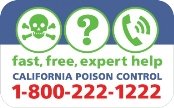Toxic plants can be found not only in parks and wilderness areas, but also in gardens and homes. These plants either have natural poisonous chemicals that can cause harm or may become toxic from pesticides, report officials with California Poison Control (CPCS).
Both indoor and outdoor plants are temptations that children commonly eat. This puts them at a major risk of accidental poisoning—especially if they are under five-years old, added Health Grades. To protect your child, you need to know which plants are toxic in order to prevent these incidences from happening.
“Most of the time plant poisonings are mild, simply requiring observation and no treatment,” said Dr. Rais Vohra, Medical Director for the Fresno/Madera Division of CPCS. “But there are other plants that pose a serious risk of illness, injury, and even death.”
According to the California Childcare Health Program at the University of California San Francisco (UCSF), there are a number of plants commonly found both indoors and out that can be highly toxic. Some of those listed here may be in your home or yard:
Castor Bean (castor oil plant);
Dumbcane (Dieffenbachia);
English Ivy (Hedera helix);
Jerusalem Cherry (Solanum pseudocapsicum);
Mistletoe;
Oleander (Nerium oleander);
Philodendron;
Rhododendron.
Symptoms of plant poisoning vary depending upon the plant, the part of it ingested (fruits, berries, leaves, stems, or roots), the amount consumed, and other variables, such as whether it was simply skin contact with either the plant itself or a substance from the plant. While each situation is unique, toxic symptoms can include red, itchy rashes; vomiting and diarrhea; and some can have effects on the heart, liver or kidneys.
“Some symptoms can appear within minutes while others can be delayed,” Dr. Vohra said. “So it is important to always call Poison Control if your child, you, or another loved one has touched or consumed a plant or part of a plant, including wild mushrooms, that may potentially be poisonous.”
Reduce Your Child’s Risk of Plant Poisoning
Know the types of plants that are in your home, work, or school environment.
Have the common and Latin names of plants available.
Keep houseplants away from children.
Supervise young children when they are outside, whether in your yard or in wild areas.
What to Do for a Plant Poisoning
Call the Poison Hotline at 1-800-222-1222. Even if you are not sure, it will not be a waste of time.
When you call the Poison Hotline about a plant poisoning, it is best to have a name of the plant involved. You can have either the common name or the Latin name. Poison Hotline staff cannot identify plants over the phone from a description of the plant.
Do not induce vomiting.
Remove any plant parts from the mouth or hands. Keep any pieces of the plant for identification.
Wash around the mouth and hands and give a few sips of water.
Check for any irritation of the skin, mouth, or tongue.
Do not wait for symptoms to appear. Treatment will be more difficult once symptoms have developed.
If you are advised to go to the hospital, take the plant or part of the plant with you.
Call Poison Control at 1-800-222-1222 (number is the same in all states) for questions about poison encounters. Trained pharmacists, nurses and other providers are available to help 24 hours a day, seven days a week. The service is free, confidential and interpreters are available. Get weekly tips about safety by texting TIPS to 20121 for English or texting PUNTOS to 20121 for Spanish. Follow CPCS on Facebook and on Twitter @poisoninfo. CPCS is part of the University of California San Francisco School of Pharmacy and is responsible to the California Emergency Medical Services Authority.





